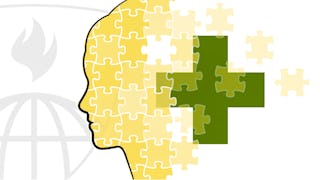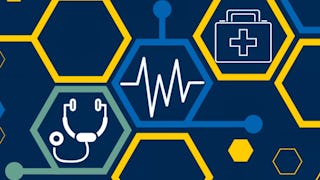Stress First Aid (SFA) is a peer support toolkit designed to preserve life, prevent further harm, and promote recovery. Stress First Aid offers a flexible menu of options for recognizing and addressing stress reactions. It can be used for self-care, to help co-workers with stress reactions, or to help someone seek other types of support. Stress First Aid is a framework of practical actions that can help reduce the likelihood that stress reactions will develop into more severe or long-term problems. Ideally everyone in an organization would learn the vocabulary and basics of Stress First Aid, to share a language and understanding of stress and stress injury. When everyone in an organization is trained in SFA, support could occur wherever and whenever it’s needed.

Enjoy unlimited growth with a year of Coursera Plus for $199 (regularly $399). Save now.

Stress First Aid for Healthcare Workers: A Peer Support Tool



Instructors: Sean Convoy
2,818 already enrolled
Included with
(17 reviews)
Recommended experience
What you'll learn
Differentiate the range of presentations of stress within the stress continuum model.
Distinguish yellow zone from orange zone stress(ors) and identify four sources of orange zone stress.
Recognize “Grow the Green” mental wellness practices for individuals and groups.
Apply the Stress First Aid principles of Continuous, Primary and Secondary Aid through case exemplar.
Skills you'll gain
Details to know

Add to your LinkedIn profile
5 assignments
See how employees at top companies are mastering in-demand skills

There are 4 modules in this course
In the first week of "Stress First Aid for Healthcare Workers," we'll lay the foundation for understanding stress and stress injury. We’ll discuss the unique stressors that healthcare professionals face in their daily practice and gain crucial insights to recognize early signs of stress injury. By the end of this week, you'll have the vocabulary to discuss stress within the context of the Stress First Aid peer support model.
What's included
5 videos10 readings2 assignments2 discussion prompts
In the second week of "Stress First Aid for Healthcare Workers", we will link the stress first aid model to both the stress continuum and four sources of orange zone stress providing learners with a framework from which to assess when stress first aid is needed. We will deconstruct the stress first aid model emphasizing Continuous, Primary, and Secondary Aid strategies linking them to a set of actionable behaviors designed to preserve life, prevent further harm, and promote recovery. Upon completion of Week 2 content, participants will gain a greater appreciation for why stress first aid is optimally delivered by peers because peers have already acquired the necessary context to care for those around them in the workspace.
What's included
9 videos7 readings1 assignment7 discussion prompts1 plugin
This week, you will focus on methods that will encourage growth within the green zone of the Stress Continuum. While we’ve talked about Stress First Aid mostly in relation to when individuals are facing a crisis (orange or red zone), it is also important for us to recognize that it’s important to recognize opportunities for wellness and resilience-based practices. As we move toward the final week of the course, we’ll also consider what we need to understand about ourselves as caregivers of Stress First Aid.
What's included
6 videos9 readings1 assignment5 discussion prompts
This week you will apply the content learned from weeks 1, 2 and 3 through case study application. Through case studies, you will be challenged to apply Continuous, Primary and Secondary Aid strategies through the prism of the stress continuum. Additionally, we will provide additional guidance around the value of performing your own community resource list so that you will be best prepared to support peers wherever they may fall along the Stress Continuum.
What's included
9 videos11 readings1 assignment8 discussion prompts
Offered by
Explore more from Psychology
 Status: Preview
Status: PreviewJohns Hopkins University
 Status: Preview
Status: PreviewUniversity of Michigan
 Status: Preview
Status: PreviewUniversity of Toronto
 Status: Preview
Status: PreviewStarweaver
Why people choose Coursera for their career




Learner reviews
17 reviews
- 5 stars
82.35%
- 4 stars
11.76%
- 3 stars
5.88%
- 2 stars
0%
- 1 star
0%
Showing 3 of 17
Reviewed on Aug 9, 2025
Excellent course. Took alot from it. Go at your own pace was appreciated.
Reviewed on Nov 25, 2025
I really enjoyed this course! it really gave me a better understanding and way to help my peers in need.
Reviewed on Jun 18, 2025
Great course. Information presented clearly. Information is actionable in creating a wellness initiative in current healthcare system

Open new doors with Coursera Plus
Unlimited access to 10,000+ world-class courses, hands-on projects, and job-ready certificate programs - all included in your subscription
Advance your career with an online degree
Earn a degree from world-class universities - 100% online
Join over 3,400 global companies that choose Coursera for Business
Upskill your employees to excel in the digital economy
Frequently asked questions
Upon completion of Stress First Aid: A Peer Support Tool, you’ll be eligible for 9.00 credits (AMA PRA Category 1 Credit(s), ANCC, Attendance, JA-Credit-AH) through the Duke University Health System Clinical Education and Professional Development Office. Once you complete the course and final course evaluation, you will be able to request continuing education credit.
Please note that continuing education credit rosters will be collected quarterly. A representative from the Duke Clinical Education and Professional Development Accreditation Office will reach out to you with the next steps to obtain your CE credits. Should you have any questions, feel free to email us at duson_sfa@duke.edu.
To access the course materials, assignments and to earn a Certificate, you will need to purchase the Certificate experience when you enroll in a course. You can try a Free Trial instead, or apply for Financial Aid. The course may offer 'Full Course, No Certificate' instead. This option lets you see all course materials, submit required assessments, and get a final grade. This also means that you will not be able to purchase a Certificate experience.
When you purchase a Certificate you get access to all course materials, including graded assignments. Upon completing the course, your electronic Certificate will be added to your Accomplishments page - from there, you can print your Certificate or add it to your LinkedIn profile.
More questions
Financial aid available,


